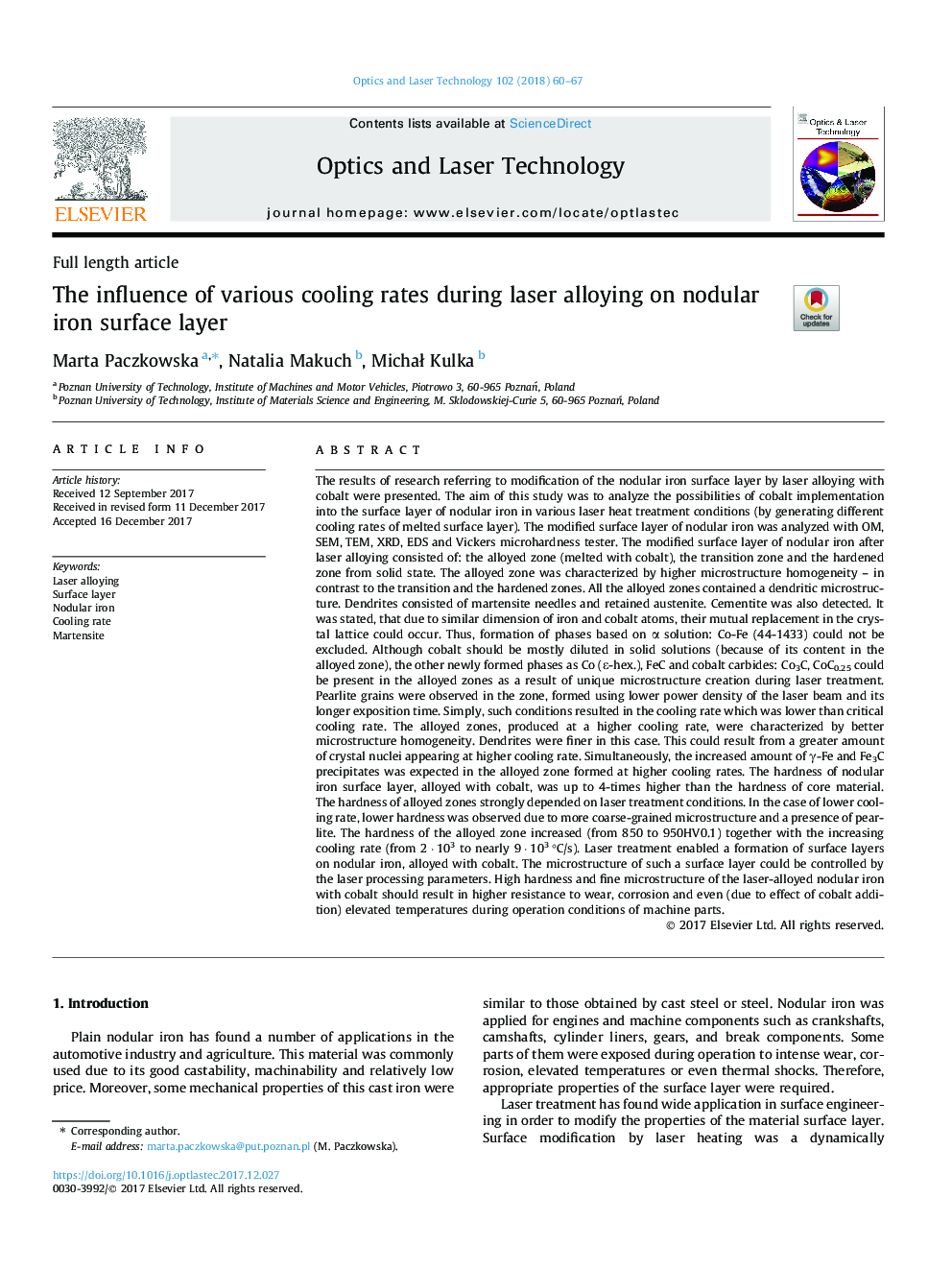| کد مقاله | کد نشریه | سال انتشار | مقاله انگلیسی | نسخه تمام متن |
|---|---|---|---|---|
| 7129023 | 1461597 | 2018 | 8 صفحه PDF | دانلود رایگان |
عنوان انگلیسی مقاله ISI
The influence of various cooling rates during laser alloying on nodular iron surface layer
ترجمه فارسی عنوان
تأثیر میزان خنک کننده های مختلف در طول آلیاژ لیزر بر لایه سطحی آهن ندولار
دانلود مقاله + سفارش ترجمه
دانلود مقاله ISI انگلیسی
رایگان برای ایرانیان
کلمات کلیدی
آلیاژ لیزری، لایه سطحی، آهن ریه ای نرخ خنک کننده، مارتنزیت،
موضوعات مرتبط
مهندسی و علوم پایه
سایر رشته های مهندسی
مهندسی برق و الکترونیک
چکیده انگلیسی
The results of research referring to modification of the nodular iron surface layer by laser alloying with cobalt were presented. The aim of this study was to analyze the possibilities of cobalt implementation into the surface layer of nodular iron in various laser heat treatment conditions (by generating different cooling rates of melted surface layer). The modified surface layer of nodular iron was analyzed with OM, SEM, TEM, XRD, EDS and Vickers microhardness tester. The modified surface layer of nodular iron after laser alloying consisted of: the alloyed zone (melted with cobalt), the transition zone and the hardened zone from solid state. The alloyed zone was characterized by higher microstructure homogeneity - in contrast to the transition and the hardened zones. All the alloyed zones contained a dendritic microstructure. Dendrites consisted of martensite needles and retained austenite. Cementite was also detected. It was stated, that due to similar dimension of iron and cobalt atoms, their mutual replacement in the crystal lattice could occur. Thus, formation of phases based on α solution: Co-Fe (44-1433) could not be excluded. Although cobalt should be mostly diluted in solid solutions (because of its content in the alloyed zone), the other newly formed phases as Co (ε-hex.), FeC and cobalt carbides: Co3C, CoC0.25 could be present in the alloyed zones as a result of unique microstructure creation during laser treatment. Pearlite grains were observed in the zone, formed using lower power density of the laser beam and its longer exposition time. Simply, such conditions resulted in the cooling rate which was lower than critical cooling rate. The alloyed zones, produced at a higher cooling rate, were characterized by better microstructure homogeneity. Dendrites were finer in this case. This could result from a greater amount of crystal nuclei appearing at higher cooling rate. Simultaneously, the increased amount of γ-Fe and Fe3C precipitates was expected in the alloyed zone formed at higher cooling rates. The hardness of nodular iron surface layer, alloyed with cobalt, was up to 4-times higher than the hardness of core material. The hardness of alloyed zones strongly depended on laser treatment conditions. In the case of lower cooling rate, lower hardness was observed due to more coarse-grained microstructure and a presence of pearlite. The hardness of the alloyed zone increased (from 850 to 950HV0.1) together with the increasing cooling rate (from 2â¯Â·â¯103 to nearly 9â¯Â·â¯103â¯Â°C/s). Laser treatment enabled a formation of surface layers on nodular iron, alloyed with cobalt. The microstructure of such a surface layer could be controlled by the laser processing parameters. High hardness and fine microstructure of the laser-alloyed nodular iron with cobalt should result in higher resistance to wear, corrosion and even (due to effect of cobalt addition) elevated temperatures during operation conditions of machine parts.
ناشر
Database: Elsevier - ScienceDirect (ساینس دایرکت)
Journal: Optics & Laser Technology - Volume 102, June 2018, Pages 60-67
Journal: Optics & Laser Technology - Volume 102, June 2018, Pages 60-67
نویسندگان
Marta Paczkowska, Natalia Makuch, MichaÅ Kulka,
